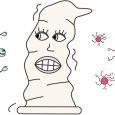We all know that sex is fun and exciting. Not to mention that it also uses up a few extra calories that we need, and it significantly reduces our level of stress. It also makes our muscles hurt with such delicious pain after having reached that magnificent feeling, the “big O.”
Sexual relationships help us learn a lot more about ourselves, about our boundaries and fears, and every other aspect of intimacy. However, in order to keep our sexual experience just as it should be, we need to take care of the basics first – we need to take care of our intimate health.
Precautions
Taking healthy precautions is imperative, especially if you’re just beginning a sexual relationship with a new partner. We’re not talking only about the possibility of an unwanted pregnancy, we’re talking about STDs. While it’s easy to avoid thinking of them, believing that we’re all responsible adults and that it can’t happen to us, sexually transmitted diseases can easily turn your experience from pleasure to various degrees of pain, and in worst case scenarios, STDs can likely lead to death. Before we list the most common STDs and their symptoms, let’s talk about the general health complications that they bring.
Disclaimer: condom-sizes.org is supported by its readers. When you buy through links on our site, we may earn an affiliate commission. Learn more.
Every year, close to 500 million people all over the world are infected with some form of sexually transmitted diseases. Male or female, rich or poor, straight or homosexual – it doesn’t make any difference. Anyone can get the disease, whether they’re having vaginal, oral or anal sex, and the more sexual partners they have, the chances of getting any type of STD significantly increase. However, it’s important to point out that a large number of sexual partners isn’t the only way of getting an STD, but it’s among most common reasons of getting an infection.
Silent Symptoms
The tricky thing about STDs is that the symptoms, especially of herpes and HPV, can be dormant for a long time before showing up in their full form, and they can cause severe damage to our reproductive organs and our health in general. By not being aware that we have a disease, we’re putting all of our sexual partners in danger of becoming infected as well.
Of course, our sexual partners aren’t the only ones who are in danger if we are infected. If a mother has an STD, the risk of stillbirth, lower-than-average birth weight, pneumonia, and that’s just to name the few, it is likely to be transferred to her child.
One of the reasons why the symptoms are so hard to detect is because it’s easy to think that the symptoms are linked to some other illness entirely. For example, one symptom of chlamydia is strong pain or a sense of burning while urinating. It’s usually looked at as nothing more but a mild bladder infection that will heal within a few days or weeks, rather than chlamydia. Of course, not every bladder issue is a reason to raise a red flag and go see the doctor, but if the pain and burning continues for a long period of time, especially if you’ve recently had sex, seeking medical help is highly recommended before things get out of hand.
Every STD has its own list of symptoms that sometimes overlap, so it isn’t uncommon to mistake one for the other. It’s very important not to do your own diagnosis based on the list of symptoms mentioned below, as this article simply provides information on the various types of STDs. Turn to a medical professional before making any kind of diagnosis, as only the doctor can provide you with complete information regarding your type of illness.
Here is a list of most common STDs and their symptoms
Gonorrhea – is quite common among the young adults starting their sexual life. It is a bacterial infection that may cause discomfort in genitals, rectum, and even throat. Burning sensation while urinating or discharge from penis/vagina are most common symptoms.
Discharge may be either yellowish or even greenish. In some cases, it may cause infection of rectum and throat too. Although, in most cases, it is readily treated with antibiotics, but in recent years it has started making a resurgence due to the emergence of antibiotic resistance.
Trichomoniasis – is another common STD and it is estimated that each year 3.7 million individuals are infected in the US alone. It is difficult to diagnose as only 30% of cases develop any symptoms and rest of the people are salient carriers of the infection.
Those who develop symptoms may report irritation in the genitals, discharge that smells, and discomfort while urinating. Trichomoniasis is caused by a parasite. Once diagnosed, it can be treated in most of the cases.
Human papillomavirus infection (HPV) is a genital virus. There are over 100 known HPV types, and at least 30 of them are sexually transmitted. It shouldn’t be confused with genital herpes, because even though they’re both untreatable and have similar symptoms, herpes can remain dormant for a long time before it becomes active in certain situations when your immunity level drops.
Some types of HPV can lead to cervical cancer in women. The symptoms may include itching in the genital area, red spots and swelling, and bleeding during intercourse. The itching can be anywhere, from the vagina to anus. In men, HPV symptoms are usually either around the anus or shaft of the penis.
One of the symptoms of HPV is the appearance of warts. It is necessary to know that warts may not occur in most cases as immunity can defeat the virus, however, in some cases, they appear and are difficult to overcome. In a small number of instances, HPV may cause genital warts (especially in people with low immunity).
Sometimes these warts may also appear near the anus; some may develop plantar warts too (on heels or balls of feet).
A few years back US FDA has approved vaccine against some strains of HPV that are known to cause cancer in men and women.
Genital herpes simplex virus (HSV) has such mild symptoms that it can take years before the person even realizes they’re infected. The infection spreads through even the slightest tears and wounds on the skin. Even oral sex can be potentially dangerous, if the partners are unaware that one of them is infected and one of them has tiny wounds inside the mouth.
The problem with HSV is that nobody knows when the symptoms will show up and with which intensity. With some people, it’s dormant for years and then the symptoms are so mild that they’re barely noticeable. Other people experience a full blast of symptoms that continue to rise up more frequently, as opposed to people whose symptoms show up once in a few years.
HSV symptoms include pain and itching in and around the genital area and anus, as well as blisters and ulcers on said areas. When HSV is activated, the person may also feel symptoms that are usually linked with a common cold, such as fever, headache, and especially muscle pain around the thighs and the groin.
HSV is incurable, but there are medications and vaccinations available that contain the disease and eases some of the discomfort.
Chlamydia is a bacterial disease, and its symptoms are similar to those of bladder problems. The person may experience pain in their lower abdomen, pain during peeing and sex and unusual bleeding for women, usually between the regular cycles. The good news is that chlamydia is generally curable, mostly with antibiotics.
Hepatitis B and C are diseases caused by a virus that prevents your liver to function normally. Even though it’s possible to get Hepatitis B or C from sharing a drug needle, it is also transmitted during sex. The symptoms, if they show up, are abdominal pain, vomiting, nausea, muscle pain, and abdominal discomfort, among others. Pharmaceutical companies have developed certain medications and vaccinations to successfully keep the inflammation under control.
Human immunodeficiency virus (HIV) is a slow, silent killer. As its name clearly says, it disables our immune system to function properly. When the immune system drops, we are prone to becoming infected with various viruses and diseases. The first clues of HIV infection are usually disregarded as a mere flu. High temperature, swollen lymph glands, soreness and fatigue are just a few of the symptoms. After the symptoms draw back, you can go for years without them rising to the surface once again. In most cases, HIV progresses to AIDS (acquired immune deficiency syndrome) over the period of few years.
As with HSV, the virus can be dormant for a very long time, sometimes throughout decades, before becoming active again. As the virus spreads inside your body, the symptoms get heavier, such as chronic fatigue, continuous headaches and fever that lasts for weeks, to name the few.
Getting an STD in most cases, if the symptoms are dormant, doesn’t prevent us from having a normal life and an enjoyable sexual experience, but it can be prevented by taking a few simple steps, such as keeping track of your sexual activity, as most of these diseases come up within weeks of having sex with the infected partner.
To help prevent contracting STDs, reduce your number of sexual partners and, most importantly of all, have protected sex and regular health control. Condoms may not prevent all STDs, but they significantly lower the risk of getting infected.






 Peter started condom-sizes.org in 2011 after realizing what a difference using a proper condom size really makes! In 2012 he published an e-book called 'How to Find Your Perfect Condom' which is still available on
Peter started condom-sizes.org in 2011 after realizing what a difference using a proper condom size really makes! In 2012 he published an e-book called 'How to Find Your Perfect Condom' which is still available on
I have genital herpes but only have outbreaks occasionally I do not have sex during outbreaks. I have never given it to my spouses because I know the symptoms. I am in a relationship now and I am careful about outbreaks but am scared to death to tell him. Its a fairly new relationship. So far only one outbreak and avoided sex until it was completely gone.